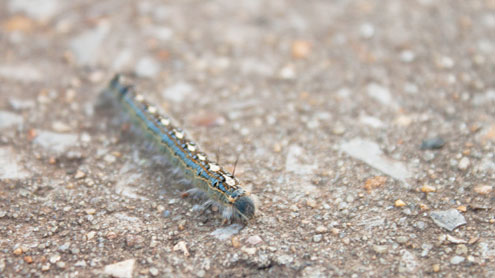An object fell from the sky and struck Amelia Warriner’s laptop keyboard with a sudden “thwack.”
“Speak of the devil,” the sophomore nursing major said.
The devil in question, a dark, tan-furred caterpillar with turquoise stripes running down its back, had just dive-bombed onto Warriner’s computer from its perch in the branches of the tree above.
The sneak attack quickly verified Warriner’s barely completed assertion that “the caterpillars are all over the place this year.” These forest tent caterpillars have come out in full force on the Quad over the past few weeks, tickling the necks, arms and legs of students who take to the outdoors to study, walk to class or throw a Frisbee.
“They’re everywhere,” said Ben Sleight, a freshman who has yet to declare a major, though he said he has not personally come in direct physical contact with any of the multiple-legged visitors.
Warriner has had the opportunity to get much more up-close and personal.
“I had them on my face in lab the other day. I guess I picked them up on my way to class,” she said. “This girl in my group pointed and said, ‘What’s in your hair?’ I looked down and ‘ah!’ it was a big caterpillar.”
It’s no coincidence University of Alabama students have begun noticing the explosion of caterpillars on campus before any other insects have made their presence significantly known.
According to a 1996 report on the caterpillar from L.L. Hyche, a professor in Auburn University’s entomology department, “it is among the first insects to break winter dormancy and become active in the spring,” and “is common and often abundant in Alabama.”
Hyche’s article said fully-grown caterpillars lay eggs in the spring, and the new “insect spends the winter as dormant, first-stage caterpillars in un-hatched eggs.” The eggs begin hatching in late February and early March. These caterpillars start the cocoon-building process through mid-April into late May, with moths emerging from early May to the beginning of June. The brown moths, according to a leaflet from the United States Department of Agriculture Forest Service, usually live for only a few days after leaving their cocoons.
The forest tent caterpillars may not have been around for very long, but students feel the ubiquitous visitors have already made a grander entrance than in past years.
“They weren’t here last year,” Warriner said, “at least not in such crazy numbers like they are now.”
The unusually warm winter experienced on campus and the surrounding area may be to blame. According to the USDA pamphlet, “freezing just prior to, during and following hatching kill many of the young caterpillars.” The virtual absence of these freezing conditions set the stage perfectly for a flourishing caterpillar population.
They may be a nuisance for students looking to relax on the Quad, but the caterpillars may serve as a more aggravating factor for the trees they inhabit. According to Hyche’s report, the insects are aggressive feeders that have been known to consume all of a host tree’s foliage. The caterpillars usually do not harm or damage the trees, but their voracious eating habits can slow growth or reduce aesthetic appeal.
The report pointed to the success of regular pest management programs in controlling outbreaks in commercial orchards and recommended measures to limit populations in recreational areas where the insects’ presence could cause irritation.
However, Warriner has developed her own caterpillar management system in favor of resorting to pesticides.
“For some reason, my dog really likes to eat them,” she said. “So I just feed them to him.”







